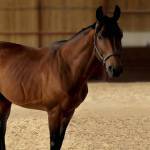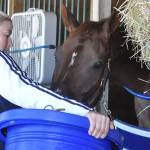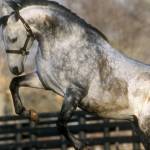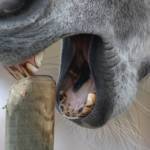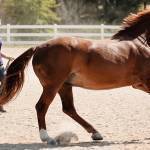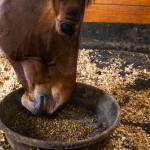Nutrition Management for Horses During Severe Drought
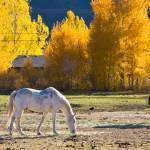
Grazing is the most natural way for horses to get nourishment. However, good pasture depends on adequate rainfall. Almost any region can be subject to drought, which quickly impacts plant growth. At the beginning of a drought, it is usually impossible to know how long it will last, how severe it will become, and how widespread the effects will be. It is possible that you will experience a drought of some description at some stage, so becoming familiar with the weather patterns and average rainfall of your areas will help you to prepare to some extent for dry periods.
Throughout a drought, particularly a long one, continually take stock of the situation and reassess your ability to keep your horses healthy and well fed. If it is becoming too expensive, you may have to sell some of your stock in order to sustain the rest. It is unlawful to allow horses to go without food and become malnourished. If you have competition or breeding horses, you may decide to rest them or board them on a property that has some pasture in order to reduce their feeding requirements and thus reduce the associated costs.
You may have to make frequent changes to your horse’s diet during a drought as different ingredients become unavailable and a new source of a nutrient is found. Frequent changes to the diet, unfamiliar ingredients, and more concentrates in the ration increase the risk of colic, gastric ulcers, laminitis, and parasites.
Provide as much hay or other roughage as possible, and provide energy in the form of fiber and fat to minimize the quantity of grains. Introduce all new feeds and ingredients, including different types of hay and chaff, gradually. If you have to feed a large amount of grain for energy, feed little and often: feed no more than 2.5 kg (5.5 lb) of concentrate (excluding chaff) in each meal, and provide three or even four meals per day. Provide plenty of fresh water, whatever the cost, even if you have to move your horses to a new area.
Gastric ulcers are precipitated by feeding a diet high in grains and from the stress of work or travel. Again, minimize the amount of grain in the diet during a drought and feed small meals with plenty of forage. Use chaff or a chaff substitute to slow down consumption, and feed as much hay as you can provide.
Horses are at high risk of laminitis with drought feeding practices. Always change the diet very slowly, feed small meals, and use digestible grains such as oats or heat-processed grains to reduce the risk of starch overflow to the hindgut.
Dry conditions do not favor survival of the larval stage of intestinal worms, so their concentration in the paddock is less during drought, but if there is a lack of forage, horses may start to eat droppings and graze the rough areas of the paddock. Continue to maintain a regular deworming program during drought to ensure that the horses get the maximum benefit from their feed, and regularly remove droppings from the paddock or yard.
Horses may begin eating tree bark or the fences if there is insufficient forage in the diet. If possible, make more forage available, either as hay or chaff, or use one of the alternatives.
When the drought is over and rain finally comes, everyone breathes a collective sigh of relief, but the problems do not end with the first patter of the life-giving drops. Paddocks that have become dry and dusty will take time to fully recover, and until then the dangers to your horse of fresh, new grass will also have to be carefully managed. The temptation is to put the horses back into a paddock that is lush with new growth and feel the glow of satisfaction from watching them graze.
As with all dietary changes, however, the introduction to new pasture must be done slowly to avoid the risk of colic and laminitis. If possible, start by allowing just a couple of hours each day on the new pasture to assist both the changeover in diet for the horse and the recovery of the pasture. During the first months after the drought has broken, build up the period of time spent on pasture, moving the horses to different paddocks so that the new pastures will not become depleted immediately. If you can, selectively graze your pasture by using temporary fencing. Beware of putting horses on pasture where there is insufficient grass, even though the field appears green. You will need to continue with supplementary forage until there is sufficient pasture for the horse to graze consistently. You can gradually wean the horses off any extra grain and resume your usual management systems. However, for those horses that have lost body condition during the drought despite your best efforts, continue to provide enough feed to recover body condition before changing the ration.

